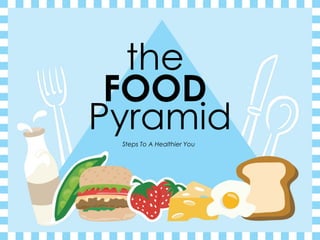Food Guide Pyramid
- 1. the Steps To A Healthier You FOOD Pyramid
- 2. Eating Right Every Day What to know: The relationship between good health and nutrition. What you need to eat to maintain a balanced diet. What your intake of calories in each food group should be.
- 4. Grains âMake Half of Your Grains Wholeâ Sources: Any food made from wheat, rice, oats, cornmeal, barley or another cereal grain is a grain product. Examples: Bread, pasta, oatmeal, breakfast cereals, tortillas, and grits Benefits: Grains are important sources of many nutrients, including dietary fiber, several B vitamins, and minerals (iron, magnesium, and selenium).
- 5. Vegetables âVary Your Veggiesâ Sources: Any vegetable or 100% vegetable juice counts as a member of the vegetable group. 5 Groups of Vegetables: Dark Green: Broccoli, Spinach, Collard Greens, Romaine Lettuce, Dark Green leafy Lettuce Orange: Carrots, Sweet Potatoes, Pumpkin, Squash Dry Beans and Peas: Black Beans, Garbanzo Beans, Kidney Beans, Split-Peas, Lima Beans, Soy Beans Starchy: Corn, Green Peas, Lima Beans, Potatoes Other: Cauliflower, Cucumber, Celery, Asparagus, Green Beans, Onions, Green/Red Peppers, Mushrooms, Okra, Vegetable Juice Vegetables are important sources of many nutrients, including potassium, dietary fiber, Vitamin A, Vitamin E, and Vitamin C.
- 6. Fruits âFocus On Fruitsâ Sources: Any fruit or 100% fruit juice counts as part of the fruit group. Fruits may be fresh, canned, frozen, or dried, and may be whole, cut-up, or pureed. Examples: Apples, Bananas, Strawberries, Mangos, Grapes, Grapefruits, Melons, Oranges, Peaches, Raisins, Pears, Pineapples Benefits: Most fruits are naturally low in fat, sodium, and calories. None have cholesterol. Fruits are important sources of many nutrients, including Potassium, Dietary fiber, and Vitamin C.
- 7. Oils âKnow Your Fatsâ Benefits: Contain âessential fatty acidsâ Do not raise LDL (âbadâ) cholesterol levels in the blood. Major source of vitamin E in typical American diets. Sources: Oils are fats that are liquid at room temperature (unsaturated fats), like the vegetable oils used in cooking. Oils come from many different plants and from fish. Examples: Canola Oil Olive Oil Vegetable Oil Foods high in oils (nuts, olives, fish, avocados)
- 8. Milk âGet Your Calcium Rich Foodsâ Sources: All fluid milk products and many foods made from milk are considered part of this food group. Foods made from milk that retain their calcium content are part of the group; while foods made from milk that have little to no calcium, such as cream cheese, cream, and butter, are not. Examples: Milk, Cheese, Yogurt, Ice Cream, Frozen Yogurt Benefits: Foods in the dairy group provide nutrients that are vital for health and maintenance of your body. These nutrients include calcium, potassium, vitamin D, and protein. Diets rich in milk and milk products help build and maintain bone mass throughout the lifecycle. This may reduce the risk of osteoporosis.
- 9. Meat and Beans âGo Lean On Proteinâ Sources: Meat, Poultry, Fish, Peanut butter, Eggs, Soy, Nuts, Beans Benefits: These are your protein foods. Supply many nutrients including protein, B vitamins Vitamin E, Iron, zinc, and Magnesium. Proteins function as building blocks for bones, muscles, cartilage, skin, and blood. They are also building blocks for enzymes, hormones, and vitamins. Proteins are one of three nutrients that provide calories (the others are fat and carbohydrates). B vitamins found in this food group serve a variety of functions in the body. They help the body release energy, play a vital role in the function of the nervous system, aid in the formation of red blood cells, and help build tissues.
- 10. Discretionary Calories Extras For Luxury Foods Depending on the foods you choose, you may be able to spend more calories than the amount required to meet your nutrient needs. These calories are the âextrasâ that can be used on luxuries like solid fats, added sugars, and alcohol, or on more food from any food group. They are your âdiscretionary calories.â Based on calorie needs by age/sex group. Those who are more physically active need more total calories and have a larger discretionary calorie allowance.
- 11. Physical Activity *Strive For 60 Minutes or More Per Day* Examples: Walking, working out, climbing the stairs, or playing sports. Moderate Physical Activity Walking briskly (about 3 Â― miles per hour) Hiking Gardening/yard work Dancing Golf (walking and carrying clubs) Bicycling (less than 10 miles per hour) Weight training (general light workout) Vigorous Physical Activity Running/jogging (5 miles per hour) Bicycling (more than 10 miles per hour) Swimming (freestyle laps) Aerobics Walking very fast (4 Â― miles per hour) Heavy yard work, such as chopping wood Weight lifting (vigorous effort) Basketball (competitive) VS.
- 12. My Pyramid Drawing Assignment: Draw âMy Pyramidâ using information from the PowerPoint and the MyPyramid poster. Neatness counts! ï You may not trace. Please use a straight edge or a ruler. Used colored pencils, crayons, or markers. Label each band of color. Example: Orange=Grains. Include slogans. Example: GrainsââMake half your grains whole.â VegetablesââVary your veggies.â Include serving sizes for your age and activity level. Draw at least three foods that you like to eat in each category.











